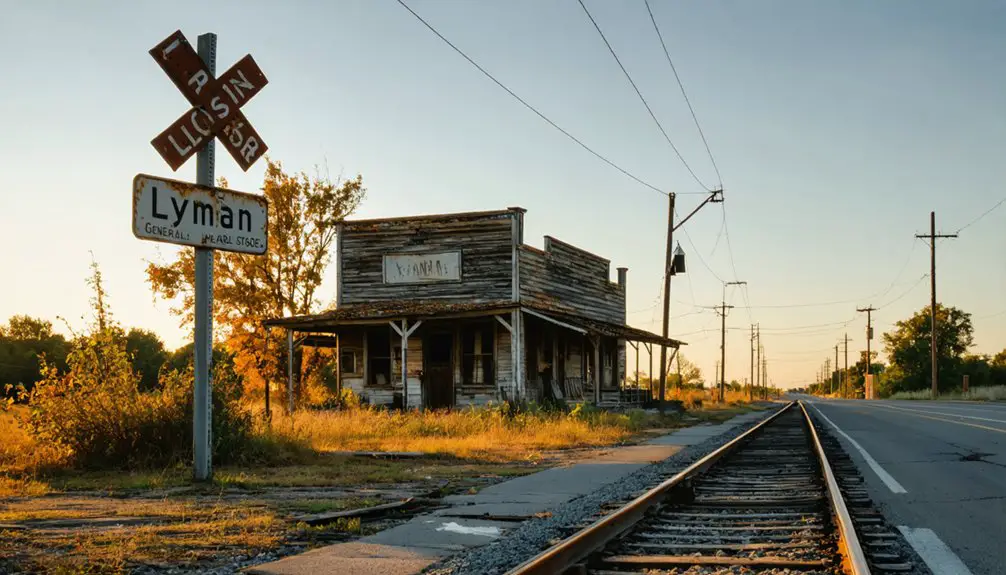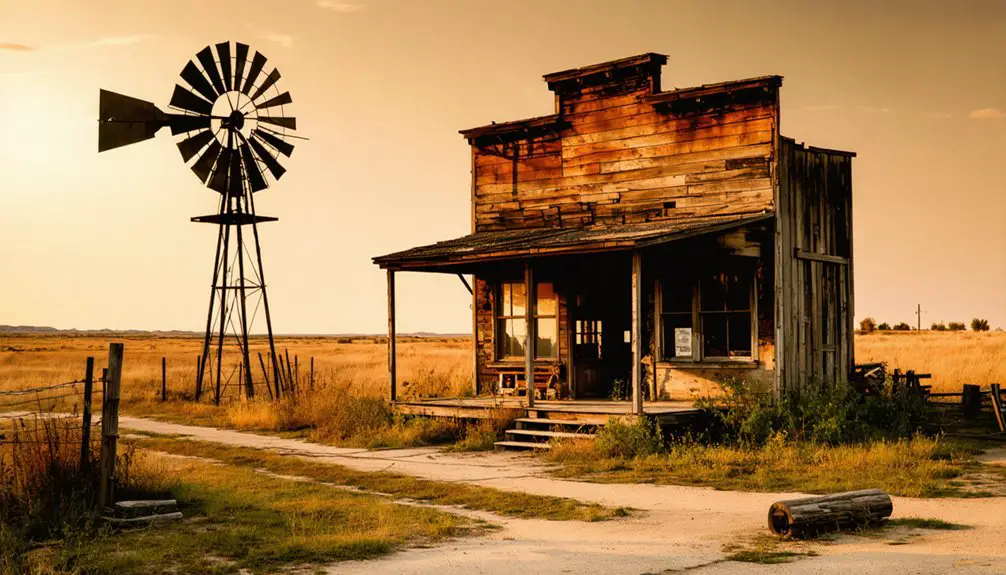You’ll find Lyman in Osage County, Oklahoma – a ghost town born from the 1920 Burbank oil field discovery. A.J. Lyman platted the settlement, which quickly grew with the arrival of the Osage Railway in 1924 and establishment of refineries. The town thrived until 1929 when the oil boom ended and the Great Depression hit. Today, only scattered remnants and crumbling foundations mark where this once-bustling boomtown stood, each abandoned structure telling a story of Oklahoma’s oil frontier.
Key Takeaways
- Lyman was established in 1920 following the discovery of the Burbank oil field, transforming from a tent settlement into a bustling boomtown.
- The town’s prosperity peaked in the mid-1920s with multiple refineries, a railway connection, and essential businesses serving the oil industry.
- Economic collapse struck in 1929 due to the oil boom’s end and Great Depression, leading to widespread abandonment of homes and businesses.
- The post office’s closure in 1956 marked Lyman’s final demise, leaving only deteriorating buildings and empty streets as remnants.
- Today, Lyman serves as a ghost town with crumbling foundations and abandoned railway infrastructure documenting Oklahoma’s oil boom history.
The Birth of an Oil Boomtown
When wildcatters discovered the lucrative Burbank oil field in 1920, they transformed the quiet plains of Osage County, Oklahoma into what would become the boomtown of Lyman.
You’d have witnessed a rapid transformation as fortune seekers flooded the area, setting up makeshift camps with tents and rough shelters that offered little protection from the harsh weather.
A.J. Lyman saw the opportunity and platted the town, selling lots to establish a more permanent settlement. Like the Lyman House projects that would later be recognized on the National Register of Historic Places, the town’s early structures represented pioneer ambition.
As oil production ramped up, you’d have seen the evolution from a crude camp to a proper town. The initial chaos of the oil discovery gave way to organized development, with a four-room brick school and essential businesses rising from the prairie.
The mix of skilled workers and entrepreneurs shaped Lyman’s early character as a bustling oilfield community. The Osage headright system ensured that tribal members benefited from the oil and gas royalties flowing from their mineral-rich lands.
Railway Connections and Early Growth
The arrival of the Osage Railway in 1924 marked a defining moment in Lyman’s evolution from a primitive oil camp to an established town. Built primarily for freight service, the railway extension from Shidler through Webb City to Lyman provided essential connections to the region’s bustling oil industry. Like many communities in the state, the town’s rapid development was driven by oil boom wealth.
You’ll find the railway’s significance reflected in Lyman’s rapid development, with a post office established by March 1924. While the rail line primarily served the oil refineries, it also offered unofficial passenger rides, connecting you to regional centers. Midland Valley Railroad provided additional transportation options through its northwestward line from Tulsa.
Despite this growth, early infrastructure remained basic – you’d have relied on local water sources and natural gas for light and heat. The railway’s presence helped Lyman’s population surge through the 1920s, though the town’s prosperity remained tightly bound to the oil industry it served.
Peak Years of Prosperity
Lyman’s peak prosperity arrived swiftly after oil’s discovery in 1920, transforming the settlement into a bustling boomtown centered around the Burbank oil field. The oil industry’s rapid expansion brought multiple refineries and a growing workforce, leading to significant development through the mid-1920s.
The discovery of oil in 1920 turned Lyman into a thriving boomtown, as refineries and workers flocked to the Burbank field.
You’ll find the town’s community resilience reflected in how residents adapted to primitive conditions while building their frontier settlement:
- Natural gas provided abundant lighting and heating despite limited infrastructure
- Rail service arrival in 1924 boosted commerce and population growth
- Post office establishment marked the town’s official recognition
- Local school served families until merging with Webb City in 1929
While lacking modern amenities, Lyman thrived through the decade before production decline began taking its toll in the late 1920s. The Elgin Oil Refining Company emerged as a major economic driver with its impressive 1,500-barrel daily capacity.
Economic Decline and Population Loss
As Lyman’s oil boom came to an abrupt halt in 1929, you’d have witnessed a dramatic transformation from bustling prosperity to rapid decline.
The Great Depression caused widespread hardship, dealing a devastating blow to the local economy. The town’s population plummeted as oil workers and their families left in search of opportunities elsewhere, leaving behind empty homes and shuttered businesses. Similar to the mining town exodus seen in places like Picher, Oklahoma in the 1960s, local residents were forced to seek work in other regions.
Local tax revenues dried up quickly, leading to deteriorating infrastructure and reduced public services that accelerated the exodus of remaining residents.
Oil Boom Ends Abruptly
When oil production in the Burbank field began its sharp decline in the late 1920s, Lyman’s fate was sealed. The town’s economic resilience crumbled as oil speculation gave way to harsh reality, coinciding with the Great Depression‘s onset. The impact rippled through every aspect of local life, fundamentally altering the town’s future.
The downturn’s devastating effects included:
- Sharp reduction in drilling and refining jobs
- Closure of the Osage Railway by 1953 due to decreased freight volumes
- Shuttering of essential services, including the school in 1929 and post office by 1956
- Abandonment of homes and businesses as workers and families departed
You’ll find the collapse wasn’t limited to the oil industry – local commerce, retail establishments, and hospitality services all suffered severe losses, transforming this once-bustling boomtown into a shadow of its former self.
Population Exodus After 1929
The devastating combination of the Great Depression and declining oil production triggered a mass exodus from Lyman throughout the 1930s.
You’ll find that economic factors hit the town particularly hard, with reduced oil demand and local business activity driving population migration away from the once-thriving community.
The town’s decline became evident through institutional closures.
First, the local school merged with Webb City in 1929 due to dwindling enrollment. By 1944, the high school’s final graduating class numbered just 16 students.
The abandonment of the Osage Railway in 1953 eliminated vital transportation access, and when the post office closed in 1956, it marked Lyman’s effective end as an organized community.
What remained were only scattered homes and oil field remnants, making Lyman another casualty of Oklahoma’s boom-bust cycle.
The Abandoned Rails and Empty Streets

Deep within Oklahoma’s forgotten landscapes, Lyman’s abandoned railway infrastructure stands as a haunting reminder of its once-thriving past.
You’ll find ghostly remnants of the Osage Railway, which served the town from 1924 until its abandonment in 1953, now slowly decaying into the earth. Similar to the Midland Valley Railroad that transformed Stigler in 1904, these rail lines once brought promise of growth and prosperity.
The town’s deterioration is evident through:
- Overgrown rail beds where trains once transported oil and passengers
- Weathered tracks and stations left untouched since the railway’s closure
- Empty streets that haven’t seen regular traffic since the post office closed in 1956
- Unmaintained public spaces that highlight the town’s ghost town status
Today, these abandoned rails and vacant streets tell a stark story of economic decline, reflecting a broader pattern across rural Oklahoma where nearly half of all rail lines faced abandonment by the late 1980s.
Life After the Boom
When you look at Lyman’s post-boom decline, you’ll see how quickly its population scattered as oil production faltered in the late 1920s and the Great Depression hit.
The closure of the school in 1929 and the post office in 1956 marked critical points in the community’s dissolution, forcing remaining residents to rely on services in nearby Webb City. Like Acme Cement Company, which suffered a similar fate when its resources ran dry, Lyman’s economic foundation crumbled as its primary industry declined.
You can trace the town’s final descent into ghost town status through the abandonment of permanent homes, deteriorating infrastructure, and the loss of rail service in 1953, which effectively sealed Lyman’s fate.
Population Exodus Patterns
As oil production steadily declined in the late 1920s, Lyman’s population began a mass exodus that would transform the bustling boomtown into a ghost town within three decades.
Economic factors and migration motivations varied, but the pattern was clear – residents were leaving, and they weren’t coming back.
Key factors driving the exodus included:
- The Great Depression’s devastating economic impact
- Closure of essential services like schools and the post office
- Loss of transportation links when the Osage Railway shut down
- Deteriorating infrastructure and housing conditions
This decline followed a common pattern seen in Oklahoma, where nearly two thousand ghost towns emerged from similar boomtown circumstances.
You’ll find that most residents relocated to nearby towns like Ponca City and Winfield, Kansas, where better prospects awaited.
Others returned to agricultural areas or sought opportunities in different oil towns that still showed promise.
Community Assets Abandoned
Following Lyman’s population exodus, the town’s physical infrastructure rapidly deteriorated into a collection of empty shells and crumbling foundations.
You’ll find Main Street’s once-bustling storefronts now reduced to vacant lots, while the four-room brick schoolhouse stands as a silent monument to the community decline. The post office closed by the mid-1950s, marking the end of essential services.
Infrastructure decay hit residential areas particularly hard. Weather and neglect transformed permanent homes into derelict structures, while former tent camps and neighborhoods lie completely deserted.
Churches and social gathering places have either collapsed or been demolished. Today, you’ll only find scattered remnants of Lyman’s community assets – a concrete jail, oil field ruins, and deteriorating roads that once connected a thriving town.
Preserving Lyman’s Historical Legacy

Through dedicated preservation efforts, Lyman’s historical legacy endures in both physical and digital forms. You’ll find several preservation strategies working together to protect this town’s historical significance, from archival research at the University of Oklahoma’s Western History Collection to digital documentation of remaining structures.
Modern preservation techniques blend traditional archival methods with digital innovation to safeguard Lyman’s rich historical heritage for future generations.
Key preservation initiatives include:
- Legal documentation through property deeds, post office records, and local government archives
- Physical site maintenance of surviving buildings, tornado shelters, and oil field remnants
- Digital archiving of photographs, maps, and historical documents
- Community engagement through museums, educational programs, and oral history collection
You can explore Lyman’s past through virtual tours, documentaries, and social media platforms, while protected access to physical sites guarantees future generations will understand this important chapter in Oklahoma’s oil boom history.
Frequently Asked Questions
Are There Any Remaining Structures or Ruins Visible in Lyman Today?
You’ll find the concrete jail still standing, along with scattered oil field infrastructure and some remaining buildings’ foundations. These historical relics mark what’s left of the once-bustling town.
What Was the Peak Population of Lyman During the Oil Boom?
Truth lies in the details, but you won’t find exact population numbers. Based on comparable oil boom patterns and infrastructure growth, Lyman’s peak population likely reached several thousand during the mid-1920s population growth.
Did Any Notable Historical Figures or Celebrities Visit Lyman?
You won’t find any record of famous visitors in Lyman’s history. The town’s historical significance remained purely local, centered on oil field workers and its founder A.J. Lyman’s development efforts.
What Happened to the Original Land Deeds and Property Ownership?
Between a rock and a hard place, you’ll find most land deed history in Osage County records, though many property transfers weren’t properly documented during the rapid boomtown development and subsequent decline.
Were There Any Major Accidents or Disasters in Lyman’s History?
You won’t find records of major mining accidents or oil disasters in Lyman’s history. Unlike other Oklahoma ghost towns, its decline came from economic factors rather than catastrophic events.
References
- https://en.wikipedia.org/wiki/List_of_ghost_towns_in_Oklahoma
- https://en.wikipedia.org/wiki/Lyman
- https://www.okhistory.org/publications/enc/entry?entry=GH002
- https://okmag.com/blog/a-ghostly-site/
- http://www.ou.edu/news/articles/2024/may/ou-researcher-unveils-book-of-oklahomas-ghost-towns.html
- https://www.youtube.com/watch?v=eyvtCW95rpY
- https://www.okhistory.org/publications/enc/entry?entry=PE023
- https://tulsahistory.org/exhibit/oklahoma-oil/
- https://nondoc.com/2022/01/04/whizbang-oklahoma-ghost-town/
- https://www.okhistory.org/publications/enc/entry?entry=OS004



